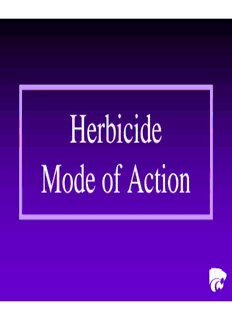
Herbicide Mode of Action (.pdf) - Agronomy PDF
Preview Herbicide Mode of Action (.pdf) - Agronomy
Herbicide Mode of Action Herbicide Mode of Action How a herbicide works Use herbicides more efficiently Recognize and diagnose injury problems Herbicide resistance management Herbicide –Plant Interactions Absorption Translocation Metabolism Mechanism of Action Physiological response Requirements for Herbicide Activity Contact with the target weed Absorption into the plant Accumulation of toxic levels at the site of action Herbicide Selectivity Differential response of plant species to a herbicide Selective Nonselective Herbicide Selectivity Application Rate Herbicide Placement Spray Retention Differential Absorption Differential Translocation Metabolism Altered Site of Action (Herbicide Resistance) Absorption of Soil-Applied Herbicides Roots Shoots Absorption of Postemergence Herbicides Leaf surface coverage Leaf surface properties Herbicide-spray properties Temperature Humidity Plant Vigor Herbicide Metabolism Chemical transformations of a herbicide in a plant Metabolism generally results in detoxification of a herbicide, but also can increase the toxicity of a herbicide Altered Site of Action Inability of a herbicide to bind to the site of action due to a genetic and conformational difference at the binding site compared to susceptible biotypes. Herbicide Resistance
Description: